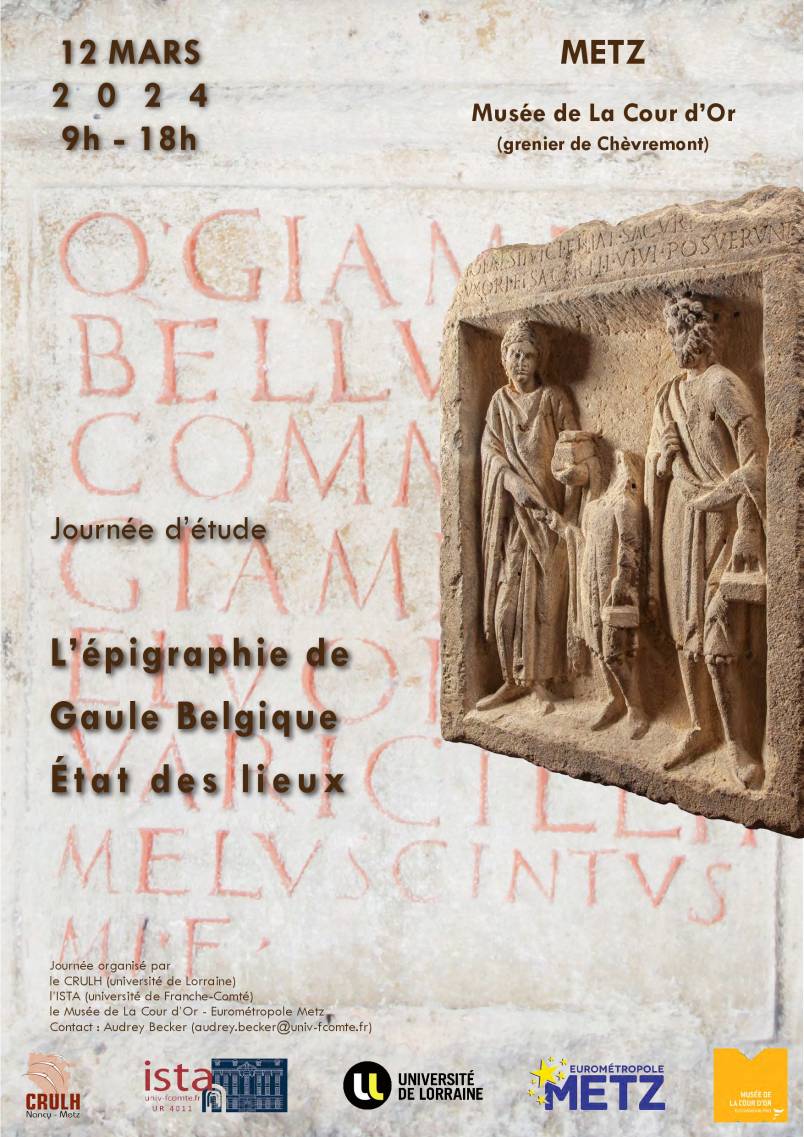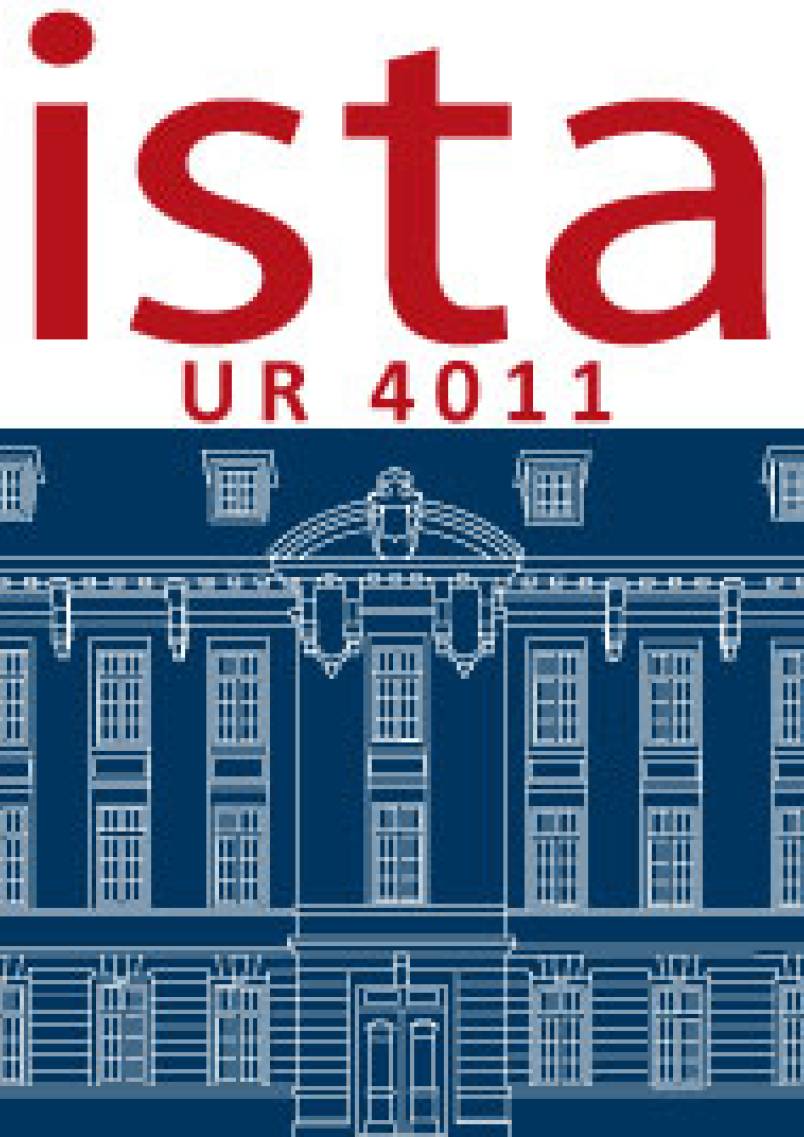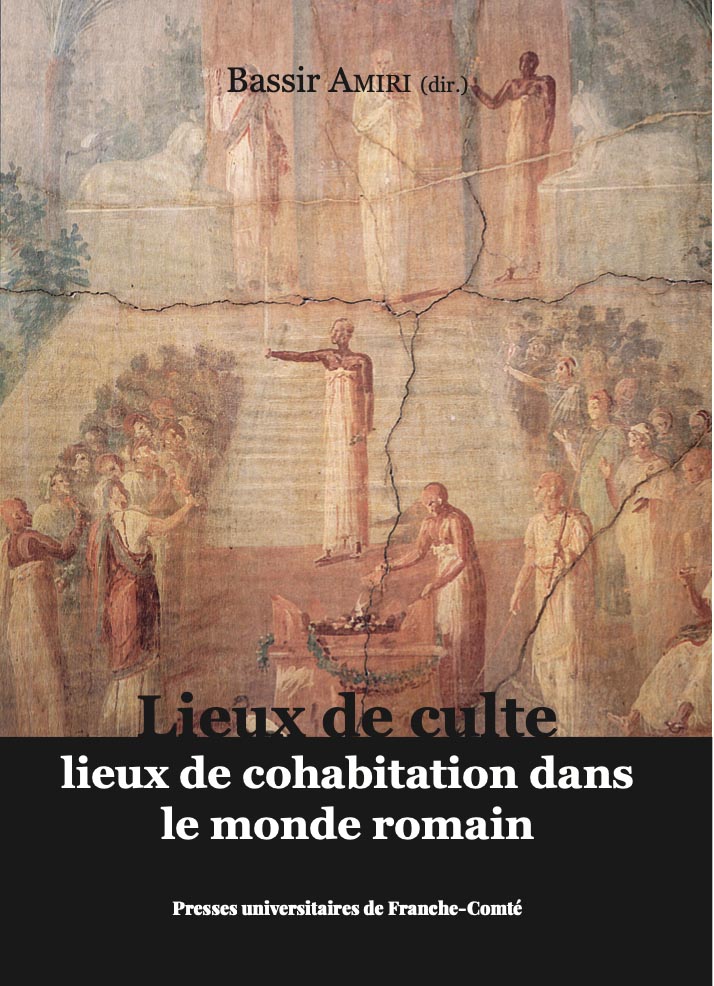PUFC
Le Canopisme commence à Eleusis (Strabon, XVII, 1, 16). Quelques réflexions sur un territoire sacré à scandale
Jean-Yves CARREZ
« Honore le dieu et oublie les hommes ! » Pausanias et la difficile cohabitation entre hommes et divinités
Jean-Christophe VINCENT
La pratique religieuse de l’esclave et du maître dans la domus : phénomènes de cohabitation dissymétrique
Bassir AMIRI
La zone sacrée du Timave : carrefour culturel et cultuel dans l’arc nord-adriatique
Federica FONTANA
Cohabitations religieuses dans le district aurifère d’Alburnus Maior en Dacie
Françoise VAN HAEPEREN, Federica GATTO
Civils et militaires dans le paysage religieux de Mayence sous le Haut Empire
Marie-Thérèse RAEPSAET-CHARLIER
Cohabitations de dédicaces dans l’Asclépiéion de Pergame. Divinités – Textes – Supports
Lavinia FERRETTI
Condividere il sacro. Collettività, contaminazioni e identità sociali nei santuari del mondo latino
Clara DI FAZIO
Les classes populaires de Rome et l’intégration par les cultes : le cas de Silvanus
Nicolas TRAN
Conclusion
The book aims to reveal phenomena of religious contact, interaction and cohabitation in the Roman world with the aim of studying the nature of the occupation or sharing of space by one or more groups of cultores.
El libro tiene como objetivo hacer percibir los fenómenos de contacto, interacción y convivencia religiosa en el mundo romano con el objetivo de estudiar la naturaleza de la ocupación o reparto del espacio por parte de uno o más grupos de cultores.
- Auteur : Federica FONTANALa zone sacrée du Timave : carrefour culturel et cultuel dans l’arc nord-adriatique[Résumé]
Située dans l’arc nord-adriatique, la zone de l’embouchure du Timave (S. Giovanni in Tuba) était connue durant l’Antiquité pour le phénomène exceptionnel de la résurgence du fleuve qui, après un long parcours souterrain, refaisait surface en se jetant dans la mer. La nature particulière du lieu, caractérisé par un paysage d'une grande beauté, mais aussi étape maritime reliée à des routes de grande importance, en a fait depuis les souvenirs mythiques – pensons au voyage des Argonautes – un lieu de débarquement des héros et un point de croisements culturels et cultuels. L’article vise à reconstruire, par l’analyse des sources littéraires, épigraphiques et archéologiques, le paysage sacré qui devait constituer une sorte de lucus, doté de mouillages et caractérisé par une dimension commerciale. Mots-clés : Timave, Diomède, Antenor, Iucus, C. Sempronius Tuditanus. Abstract: Along the North-Adriatic coastline, the area of the mouth of the Timavo river, nearby San Giovanni in Tuba, was renowned in ancient times for the extraordinary phenomenon of the springs (Italian “risorgive”) through which the river, after flowing underground for a substantial portion of its length, emerged to the surface at a short distance from the point where its waters ran into the sea. The peculiar nature of this place, whose landscape stood out for its singular beauty, as well as its being a maritime harbour connected to important roads leading inland, are factors which explain how come this spot, which was crossroads for cultures and cults, was also identified as the mythical location where heroes—one need only think of the Argonauts—came ashore. Through a careful analysis of literary, epigraphic and archaeological sources, this paper will offer a reconstruction of the sacred landscape of the Timavo river source, where a sort of lucus must have stood, equipped with moorings and rising to the dimension of an emporium just inland of the Adriatic coast. Keywords: Temavus, Diomede, Antenore, lucus, C. Sempronius Tuditanus.
- Auteur : Jean-Yves CARREZLe Canopisme commence à Éleusis (Strabon, XVII, 1, 16). Quelques réflexions sur un territoire sacré à scandale[Résumé]
Le long du « canal Canopique », entre Alexandrie à Canope, Strabon décrit des pratiques festives qu’il appelle « Canopisme ». Sous les Ptolémées, elles se déployaient à l’occasion du Nouvel An, en juillet-août, et étaient centrées sur la personne de Kanôbos, un héros spartiate associé au culte d’Osiris. Ces carnavals rapprochaient les Grecs des Égyptiens, mais aussi les hommes des femmes, dans l’esprit des Adonies grecques et des Boubasties égyptiennes. À partir d’Auguste, il fut impossible de conserver ces fondements religieux lagides, et le « Canopisme » ne fut plus qu’une sorte d’« effronterie » propre à un faubourg chic d’Alexandrie, surtout pendant la crue, comme le montre le « Canope » de la Villa Hadriana. Mots-clés : Alexandrie, Canal Canopique, Héros Kanôbos, Jour de l’An, Effronterie, Auguste. Abstract: Along the “Canopic canal”, between Alexandria and Canopus, Strabo describes festive practices which he calls “Canopism”. At Ptolemaic times, they were displayed at New Year’s time, in July-August, and centered upon the cult of Canopus, a Spartan hero associated with Osiris. These happenings brought Greeks closer to Egyptians, and also men to women, in the spirit of Greek Adoneia and Egyptian Boubasteia. After Augustus, it was impossible to maintain these Ptolemaic religious foundations, and “Canopism” became only some kind of “pertness” in a high society suburb, mainly when Nile rose, as can be seen in the “Canopus” of Villa Hadriana. Keywords: Alexandria, Canopic Canal, Hero Canopus, New-Year’s Day, Pertness, Augustus.
- Auteur : Jean-Christophe VINCENT« Honore le dieu et oublie les hommes ! » Pausanias et la difficile cohabitation entre hommes et divinités[Résumé]
Pausanias est un auteur incontournable pour comprendre la mentalité religieuse grecque. Son œuvre, capitale pour les études religieuses, ne doit pas seulement être lue comme une somme d’informations pratiques, mais aussi et surtout, comme une œuvre littéraire construite et originale. En particulier, à partir des descriptions évoquant le monde des dieux, le sanctuaire et la statuaire, il est possible de dessiner les contours d’une « idéologie » permettant une appréhension particulière du divin. La présence du divin et du sacré parmi les hommes conduit Pausanias à prendre position et à exprimer à demi-mot une vision toute personnelle de la cohabitation homme/divinité. À partir de l’étude des mots, qu’il choisit avec précision et parfois subtilité, il faudra se demander ce qu’il veut nous faire passer comme message à propos de sa propre vision, et quelles en sont les conséquences pour l’étude de la religion grecque désormais diluée dans le monde romain et soumise à de nouvelles croyances et pratiques. Mots-clés : Pausanias, Religion grecque, Vocabulaire religieux, Terre sacrée, Sanctuaire grec, Statuaire, Homme divinisé, Temenos, Agalma, Empereur romain. Abstract: Pausanias is an essential author for understanding the Greek religious mentality. His work, capital for religious studies, should not only be read as a sum of practical information, but also and above all as a constructed and original literary work. In particular, from the descriptions evoking the world of the gods, the sanctuary and the statuary, it is possible to draw the outlines of an “ideology” allowing a particular apprehension of the divine. The presence of the divine and the sacred among men leads Pausanias to take a stand and to express in half-words a very personal vision of the man/divinity cohabitation. From the study of words which he chooses with precision and sometimes subtlety, we will have to ask ourselves what he wants to send us as a message about his own vision, and what are the consequences for the study of Greek religion now diluted in the Roman world and subjected to new beliefs and practices. Keywords: Pausanias, Greek Religion, Religious Vocabulary, Sacred Land, Greek Sanctuary, Statuary, Deified Man, Temenos, Agalma, Roman Emperor.
- Auteur : Bassir AMIRILa pratique religieuse de l’esclave et du maître dans la domus : phénomènes de cohabitation dissymétrique[Résumé]
La domus romaine, lieu par excellence des cultes de la familia, faisait se côtoyer libres et esclaves, représentants de la romanité et individus importés des quatre coins de l’Empire. Lieu où interagissent des individus aux statuts juridiques différents, aux origines éventuellement diverses, la domus apparaît ainsi comme un champ d’investigation pour l’étude des phénomènes de cohabitation religieuse. En s’appuyant sur les témoignages littéraires et épigraphiques ainsi que sur la documentation abondante livrée par les fouilles des maisons de Pompéi, il s’agira d’interroger les modalités de l’implication des esclaves dans la religion au quotidien de la familia pour tenter de caractériser la cohabitation de fait qui se crée au sein de la domus. Mots-clés : Religion domestique, Esclaves, Pater familias, Domus, Lares, Penates, Laraires. Abstract: The Roman domus, known to be the place for family worship, brought together free and slaves, representatives of roman citizens and individuals imported from different territories of the roman Empire. If the Roman domus is a place where individuals with different legal status and possibly diverse origins interact, the domus thus appears as a field of investigation for the study of phenomena of religious cohabitation. By relying on literary and epigraphic testimonies as well as on the abundant documentation provided by the excavations of the houses of Pompeii, this paper will question how slaves involved in the daily religion of the familia in order to characterize the de facto cohabitation that is created within the domus. Keywords: Domestic Religion, Slaves, Pater Familias, Domus, Lares, Penates, Lararia.
- Auteurs : Françoise VAN HAEPEREN, Federica GATTOCohabitations religieuses dans le district aurifère d’Alburnus Maior en Dacie[Résumé]
Cet article est consacré aux cohabitations religieuses dans le district minier d’Alburnus Maior (Dacie), et plus particulièrement dans l’une de ses implantations, située sur le plateau de Hăbad. Les questions suivantes ont retenu notre attention. Qui sont les dédicants, qu’ils agissent collectivement ou individuellement, et quels sont les dieux qu’ils honorent ? Le travail des dédicants a-t-il influencé le choix des divinités auxquelles ils s’adressent ? Dans quelle mesure les dieux honorés à Hăbad se retrouvent-ils ailleurs à Alburnus Maior et dans les sites miniers de l’Empire ? Cette enquête vise donc aussi à offrir des pistes de réflexion sur la constitution de panthéons au sein des districts miniers de l’Empire romain. Mots-clés : Aurariae Dacicae, Alburnus Maior, Hăbad, District minier, Cohabitations divines, Acteurs cultuels, Panthéon minier. Abstract: This article focuses on religious cohabitation taking place in the Dacian mining district of Alburnus Maior and more specifically in one of its settlements, located on the Hăbad plateau. We will deal the following issues: who are the dedicators, whether they act collectively or individually, and which gods do they honour? Has the work of the dedicators influenced the choice of the gods they adress? To what extent are the gods honoured at Hăbad to be found elsewhere in Alburnus Maior or at mining sites in the Empire? This article is therefore also aiming to offer insights into the constitution of pantheons within the mining districts of the Roman Empire. Keywords: Aurariae Dacicae, Alburnus Maior, Hăbad, Mining District, Divine Cohabitations, Religious Agency, Mining Pantheon.
- Auteur : Marie-Thérèse RAEPSAET-CHARLIERCivils et militaires dans le paysage religieux de Mayence sous le Haut Empire[Résumé]
La ville de Mogontiacum-Mayence et son camp légionnaire ont livré une abondante documentation épigraphique qui permet d’étudier la répartition et l’importance des cultes à la fois chez les militaires et dans la population civile. Ce site offre une particulière opportunité de comparer panthéons et pratiques des uns et des autres et leur cohabitation, afin notamment de montrer si le rôle déterminant que l’on a parfois attribué à l’armée dans la diffusion des cultes est avéré. Mots-clés : Religion romaine, Panthéon local, Panthéon militaire, Cohabitation religieuse, Germanie supérieure, Armée romaine, Population civile, Romanisation. Abstract: The town of Mogontiacum-Mainz and its legionary camp have provided abundant epigraphic documentation that makes it possible to study the distribution and importance of cults among both the military and the civilian population. This site offers a particular opportunity to compare pantheons and practices and their cohabitation, in particular to show whether the decisive role that has sometimes been attributed to the army in the dissemination and success of cults is proven. Keywords: Roman Religion, Local Pantheon, Military Pantheon, Cohabitation of Cults, Germania Superior, Roman Army, Civilian Population, Romanization.
- Auteur : Lavinia FERRETTICohabitations de dédicaces dans l’Asclépiéion de Pergame. Divinités – Textes – Supports[Résumé]
Dans un sanctuaire antique, plusieurs divinités recevaient des offrandes inscrites. Dans le cas de l’Asclépiéion de Pergame, l’excellent état de conservation du site permet de reconstruire approximativement le lieu d’affichage original de ces objets. Il a ainsi été possible d’analyser comment les dédicaces pour différentes divinités se distribuaient dans le sanctuaire et partageaient leur lieu d’exposition. Ce cas d’étude a montré l’existence de liens entre divinité récipiendaire d’une dédicace, acte rituel donnant lieu à celle-ci, et son support et lieu d’exposition. Pour obtenir ce résultat, les cas spécifiques des ex-voto en bronze et des autels en pierre ont été analysés dans le détail. Mots-clés : Pergame, Asclépiéion, Dédicaces, Dédicataires, Supports, Distribution spatiale. Abstract: In an ancient sanctuary, many deities were given inscribed offerings. In the case of the Asclepieion of Pergamon, the good state of preservation of the site allows for an approximate reconstruction of the original place of exposition of these artefacts. Thus, it becomes possible to analyse how the dedications for various deities were disseminated through the sanctuary and shared the same space. This case study reveals the existence of links between the dedicatee of an inscribed offering, the ritual act behind it, and the materiality and place of exposition of the piece. To reach this conclusion, the specific cases of the bronze ex-voto and of the stone altars are analysed in more detail. Keywords: Pergamon, Asclepieion, Dedications, Dedicatees, Supports, Spatial Distribution.
- Auteur : Clara DI FAZIOCondividere il sacro. Collettività, contaminazioni e identità sociali nei santuari del mondo latino[Résumé]
Questo contributo intende riflettere sulle forme di condivisione del sacro e di partecipazione al culto, scegliendo quale campo di osservazione alcune delle principali aree sacre note nel contesto geo-etnografico, culturale, politico e religioso latino, caratterizzate da una frequentazione di lungo periodo. Si suggerisce una lettura trasversale di alcuni luoghi sacri come “spazi religiosi sociali”, nei quali possono cogliersi gli esiti di meccanismi di contaminazione culturale ed espressione identitaria di diverse comunità o distinti gruppi sociali. Parole chiave: Luoghi di culto, Entità sociali, Pratiche rituali, Condivisione religiosa, Spazio sacro, Religione civica. Abstract: This contribution aims to propose an analysis on the forms of sharing the sacred and worship participation, choosing as field of investigation some of the main sacred areas known in the geo-ethnographic, cultural, political and religious Latin context, characterized by a long-term attendance. A cross-cutting reading of some sacred places such as “social religious spaces” is here suggested. In this perspective, the results of cultural contamination and identity expression phenomenon can be read in the view of common behavoiur of individuals, different communities or social groups. Keywords: Worship Places, Social Entities, Ritual Practices, Religious Sharing, Sacred Space, Civic Religion.
- Auteur : Nicolas TRANLes classes populaires de Rome et l’intégration par les cultes : le cas de Silvanus[Résumé]
Bien qu’aucune fête ni aucun temple du culte public ne lui aient été consacrés, Silvain, dieu rustique des espaces boisés, était particulièrement apprécié des citoyens modestes et des esclaves de la ville de Rome. Les petits sanctuaires privés qui étaient dédiés, étaient disséminés dans l’espace urbain. Des évergètes issus de la plèbe les avaient souvent financés. Les communautés qui les fréquentaient correspondaient parfois à des associations pérennes, que ces collèges soient explicitement voués au culte de Silvain ou qu’ils affichent d’autres raisons d’être. Pour autant, il serait erroné de penser que le culte de Silvain participait d’une culture populaire, déliée de la culture dominante et de tout enracinement civique. Mots-clés : Silvain, Plèbe, Rome, Sanctuaires, Associations. Abstract: Humble citizens and slaves from Rome appreciated much Silvanus, the rustic god of woods, even if he had not a public temple in the city and a specific festival in the civic calendar. His small and private sanctuaries were spread in the whole urban space. Plebeian benefactors often funded their construction. Sometimes, communities that attended these places consisted in formal associations, explicitly devoted to Silvanus or not. However, it would be misleading to consider that Silvanus’ cult was part of a popular culture, independent from the dominant culture and from any civic rooting. Keywords: Silvanus, Plebs, Rome, Sanctuaries, Associations.





